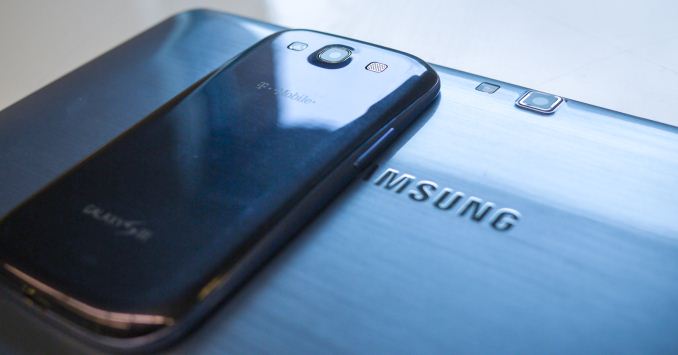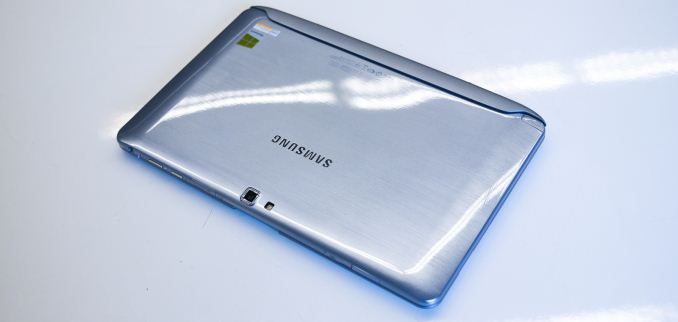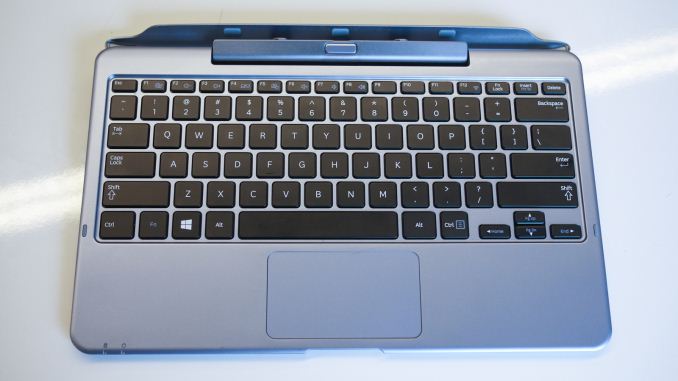Samsung ATIV Smart PC: Revisiting Clover Trail Convertibles
by Vivek Gowri on March 18, 2013 12:00 AM ESTSamsung ATIV Smart PC: Design
The ATIV Smart PC is unmistakably a Samsung design, for better or for worse. The front face is dominated by the display, along with details like the chrome-ringed Windows button, speakers placed on the right and left edges in similar fashion to the Galaxy Tab and Nexus 10, and the webcam and Samsung logo centered above the display. The bezel is uniformly three-quarters of an inch thick all the way around the screen, which allows for comfortable handling of the device without adding too much bulk to the footprint. The body is entirely glossy plastic, with contours similar to the rest of Samsung’s recent mobile industrial design language. The brushed plastic aesthetic in particular will be very familiar to anyone who has handled a pebble blue Galaxy S III or Galaxy Note II in recent times. This isn’t as dark a blue, but they’re clearly related products.
The ATIV Smart PC is kind of chunky though, with a width of 12” and a weight of 1.65lbs. It’s not that thin, either, though it does feel thicker than 9.9mm. It’s too big for ideal one handed use, and the dimensions of 10.1” slates (10.5” wide, roughly 1.25lbs) tend to be much better suited for that ergonomically. The problem though, with this slate in particular, is that it feels both bulky and not that well built. The plastic body offers pretty poor in hand feel, with a disconcerting amount of flex exhibited in normal day-to-day handling.
Samsung’s build quality on their plastic products has never thrilled me, particularly the original Galaxy S and Galaxy S III. They clearly know how to design a good looking computer, with their Series 7 and Series 9 notebooks and all-in-ones featuring attractive and well built aluminum bodies. The ATIV doesn’t even cut it from a plastic standpoint, with noticeable seams between the various injection molded plastic pieces that comprise the chassis. Next to the VivoTab, the Samsung feels bloated—the aluminum body of the ASUS is far higher quality and the thinner chassis is much better ergonomically. And compared to tablet design benchmarks like Surface and the iPad, it’s not even on the same planet.
Button and port placement is a bit haphazard, with microHDMI and volume controls on the right side, a USB port, 3.5mm combo jack, microSD card, and microSIM slot located on the top of the device, along with two chrome buttons (power and rotation lock) that are easy to confuse. One, the idea of a SIM slot on a device that doesn’t have a cellular radio is downright baffling. Two, all the ports have flaps. Three ports, a dummy SIM slot, and four flaps. It’s unclean, fiddly, and an industrial design faux pas in this day and age. I’m not necessarily the biggest fan of the top-mounted USB port, but at least it’s better than the ASUS VivoTab’s easy-to-lose and hard-to-replace dongle. Other miscellaneous design details: the raised chrome detailing around the webcam is very Galaxy S III-esque, the Wacom stylus on the side can be difficult to remove from the silo at times, and the Windows and Intel logo stickers on the back are the height of uncool.
The keyboard dock is a definite bright spot. When you add it to the slate, the total size goes up to 3.1 pounds and 0.85” thick. It’s made of a matte plastic that feels better and more solid than the tablet, with a spacious and comfortable chiclet-style keyboard along with a buttonless ELAN multitouch trackpad. The dock also has two USB ports, one on either side, and both are covered by flaps (tragic).
The tablet connects to the dock with two clips and a 13 pin trapezoidal connector, and disengages with a button located at the center of the hinge. It’s a bit buggy at times—something about the electrical connection between dock and tablet occasionally goes on the fritz, resulting in a series of disconnections and reconnections usually fixed by adjusting the hinge angle or removing and reinserting the tablet. Unlike ASUS keyboard docks, the Samsung docks don’t include a battery. This results in a thinner, lighter dock, but having a second battery in the dock would probably be worth the extra bulk, for reasons I’ll discuss in the battery life section.
The ATIV Smart PC design and hardware is adequate, but honestly, based on the Windows tablets I’ve been dealing with in the last six months, I’d put Samsung behind Microsoft, ASUS, Vizio, and even Acer when it comes to Windows 8 tablet hardware design. Compared to the level of industrial design and quality we’ve come to expect from the current crop of tablets and ultrabooks, Samsung has really missed an opportunity to even be competitive here.














59 Comments
View All Comments
Krysto - Monday, March 18, 2013 - link
Why do Clover Trail devices need to be "revisited" every couple of months? Does Intel need Anandtech to do their PR for them?BrokenCrayons - Monday, March 18, 2013 - link
Though the internal hardware and performance expectations aren't going to change until there are improvements made to the silicon, the hardware package in which it resides that includes the case, screen, interface options, and battery along with other odds and ends make devices themselves worth a look. Samsung, in this case, is different with respect to build quality that is something of a shortcoming.That aside, Clover Trail is pretty uninteresting as a platform outside of putting it in the perspective of battery life. Priced at over $700, I don't personally see the appeal of what is, in essence, a netbook that costs over double the price when compared to budget-friendly systems of only a few years ago. There's just not enough benefit to offset the cost increase over a bargin bin AMD C-60 or last-gen Atom netbook for which I can simply carry an additional battery. if I want endurance as I'd be the sort to leave the keyboard dock forever attached and rarely bother to touch the screen.
Pirks - Monday, March 18, 2013 - link
Why are you lying about Clover Trail tablet prices being over $700 when in fact they start at $479?See this as a proof: http://www.newegg.com/Product/Product.aspx?Item=N8... and this too: http://www.newegg.com/Product/Product.aspx?Item=N8...
Are you a Google and/or Apple fanatic by any chance? Just curious ;)
BrokenCrayons - Tuesday, March 19, 2013 - link
From the first page of the article:"Clover Trail meant good battery life and x86 compatibility, the inclusion of Wacom active digitizers were exciting, and the 11.6” PLS/S-IPS displays seemed promising. The two are very comparable devices, though the ASUS is priced higher at $799, and doesn’t include the laptop dock anymore (it did at launch.) That gives the Samsung a pretty sizable price advantage, as $749 is only about $50 more than the 64GB Windows RT tablets when the keyboard accessory cost is included—more than worth it given the disparity in features and capability."
Death666Angel - Tuesday, March 19, 2013 - link
You realize that you are talking about all Clover Trail tablets, while Vivek just talks about 2 very specific, premium products? If you don't need a keyboard dock and an active digitizer, you can get Clover Trail tablets much cheaper. And in turn, if you need a keyboard dock and especially an active digitizer, comparing that price with old netbooks is useless, as they are useless for that specific need.BrokenCrayons - Tuesday, March 19, 2013 - link
The scope of my original post and response do not encompass, as you imply, "all Clover Trail tablets" outside of considerations of overall platform performance. The majority of the discourse concerns the Samsung tablet in specific and its various shortcomings relative to the MSRP under consideration of the benefits offered in exchange for the costs.With regards to my needs for a various features such as an active digitizer, I've already mentioned that previously. "I'd be the sort to leave the keyboard dock forever attached and rarely bother to touch the screen." In light of my own usage model and requirements, the price of the Samsung isn't justified or reasonable when one can acquire similar performance from low cost hardware available at office supply stores.
http://www.officedepot.com/a/products/592409/Acer-...
Understandably, your personal preferences and desires for a computing platform might be different. That's perfectly reasonable, but the mold which suits your needs may not be universally applied to others.
Death666Angel - Tuesday, March 19, 2013 - link
Then you should amend that sentence:"That aside, Clover Trail is pretty uninteresting as a platform outside of putting it in the perspective of battery life. Priced at over $700, I don't personally see the appeal of what is, in essence, a netbook that costs over double the price when compared to budget-friendly systems of only a few years ago."
As you make no effort to distinguish between different CT platforms. And when you get called out for it, you quote the article which just mentions 2 examples.
duploxxx - Monday, March 18, 2013 - link
typical OEM behavior, go with the flow i.s.o. design to differentiate. There has always been a netbook atom killer called Brazos, same for the tablet space it exists, http://www.anandtech.com/show/6672/vizio-tablet-pc... no slugish gui or impossible 3d like on the clovers, i had many tabs in house for testing, just makes the all day experience horrible. from an smooth workable gui experience (swiping between screens, switching applications) on tablets: IOS > ANDROID = AMD Soc >>>>> Clover this is how you can rate the experience.nerd1 - Monday, March 18, 2013 - link
I don't care about UI experience, I do care about the active digitizer (for inking) and battery life.DanNeely - Monday, March 18, 2013 - link
The part of the Asus device chaos that's annoying me the most is that from what I can tell from their webpage; their 10" atom model is only available with a wireless keyboard and a cover that can be folded up to let the two imitate a laptop on a table while the winRT model has an actual keyboard dock with the extended battery and ability to use like a laptop even if a perfectly flat surface isn't available. The atom tablet and keydock would otherwise match what I am looking for almost perfectly.